Don't wanna be here? Send us removal request.
Text

Ophelia | John Everett Millais | 1852 | Tate Britain
"This painting depicts the death of Ophelia from Shakespeare's Hamlet. Traumatized by her family, het cancelled betrothal and the murder of her father by her fiance, Ophelia drowns in a stream after roaming the countryside looking for flowers. John Everett Millais painted the setting leaf-by-leaf by the Hogsmill river in Surrey. The artist and model Elizabeth Siddal posed as Ophelia by wearing a wedding dress in a filled bathtub. Siddal and other working - class women who joined the Pre - Raphaelite circle as colleagues, friends and wives challenged Victorian expectations of arranging marriages for money and status. "
#Ophelia#John Everett Millais#Tate Britain#tate#london#uk#united kingdom#Hamlet#william shakespeare#pre raphaelite#Elizabeth Siddal
8 notes
·
View notes
Text

Starry Night over the Rhone 1888 | Vincent Van Gogh | 1888 | Musee d'Orsay
"From the moment of his arrival in Arles, on 8 February 1888, Van Gogh was constantly preoccupied with the representation of "night effects". In April 1888, he wrote to his brother Theo: "I need a starry night with cypresses or maybe above a field of ripe wheat." In June, he confided to the painter Emile Bernard: "But when shall I ever paint the Starry Sky, this painting that keeps haunting me" and, in September, in a letter to his sister, he evoked the same subject: "Often it seems to me night is even more richly coloured than day". During the same month of September, he finally realised his obsessive project. He first painted a corner of nocturnal sky in Cafe Terrace on the Place du Forum, Arles (Otterlo, Rijksmuseum Kröller-Muller). Next came this view of the Rhône in which he marvellously transcribed the colours he perceived in the dark. Blues prevail: Prussian blue, ultramarine and cobalt. The city gas lights glimmer an intense orange and are reflected in the water. The stars sparkle like gemstones. A few months later, just after being confined to a mental institution, Van Gogh painted another version of the same subject: Starry Night (New York, MoMA), in which the violence of his troubled psyche is fully expressed. Trees are shaped like flames while the sky and stars whirl in a cosmic vision. The Musée d'Orsay’s Starry Night is more serene, an atmosphere reinforced by the presence of a couple of lovers at the bottom of the canvas."
Description from the “Van Gogh: Poets and Lovers” exhibition at London National Gallery (Autumn 2024):
"The starry sky at last, actually painted at night, under a gas-lamp" was how Van Gogh described this view of Arles from across the River Rhone. Despite painting it largely outdoors and in real time, he made compositional choices to achieve the effect he was after by positioning the constellation of Ursa Major above the scene and inventing the foreground lovers. Their presence was essential to the conception of the picture's status as a "Poetic Subject"."
#van gogh#vincent van gogh#musee d'orsay#paris#france#dutch#Starry Night over the Rhone#Rhone#Arles#neo impressionism
6 notes
·
View notes
Text

The Violin Player | Gerrit van Honthorst | 1626 | Mauritshuis
"The Utrecht painter Van Honthorst lived for a while in Rome, where he was influenced by the work of Caravaggio. He caused a sensation with his night paintings, which gave him the nickname ‘Gherardo delle Notti’, Gerrit of the Nights. But he also made cheerful figure paintings, such as this enticing young woman.
Van Honthorst was one of the Utrecht Caravaggists, and his modern, dramatic style had a great influence on Dutch painting. When he became court painter to stadholder Frederik Hendrik, his style became gradually daintier."
#The Violin Player#Gerrit van Honthorst#mauritshuis#den haag#holland#netherlands#the netherlands#caravaggio#caravaggisme#utrecht#bella ramsey
15 notes
·
View notes
Text

The Night Watch | Rembrandt | 1642 | Rijksmuseum
"Rembrandt's largest and most famous painting was made for one of the three headquarters of Amsterdam's civic guard. These groups of civilian soldiers defended the city from attack. Rembrandt was the first to paint all of the figures in a civic guard piece in action. The captain, dressed in black, gives the order to march out. The guardsmen are getting into formation. Rembrandt used the light to focus on particular details, like the captain's gesturing hand and the young girl in the foreground. She was the company mascot. The nickname Night Watch originated much later, when the painting was thought to represent a nocturnal scene."
"Rembrandts beroemdste en grootste schilderij werd gemaakt voor de Kloveniersdoelen. Dit was een van de drie hoofdkwartieren van de Amsterdamse schutterij, de burgerwacht van de stad. Rembrandt was de eerste die op een schuttersstuk alle figuren in actie weergaf. De kapitein, in het zwart, geeft zijn luitenant opdracht dat de compagnie moet gaan marcheren. De schutters stellen zich op. Met behulp van licht vestigde Rembrandt de aandacht op belangrijke details, zoals het handgebaar van de kapitein en het kleine meisje op de voorgrond. Zij is de mascotte van de schutters. De naam Nachtwacht is pas veel later ontstaan, toen men dacht dat het om een nachtelijk tafereel ging."
#rembrandt#rembrant van rijn#night watch#rijksmuseum#amsterdam#the netherlands#nederland#dutch golden age#oil#baroque#civic guards
17 notes
·
View notes
Text

A Hare in the Forest | Hans Hoffmann | 1585 | Getty Center
"Nibbling on a leaf pulled from a stalk of Lady's Mantle, an alert hare sits at the edge of a pine forest. Unlike the darkness one would expect to find in a forest, Hans Hoffmann painted a theatrically illuminated scene. Each plant and insect - snail, cricket, beetle - is seen in vivid detail. The finely wrought leaves of the thistle, the sprawling fronds of a plantain, and the bright blue flowers of the Hare Bell attest to Hoffmann's meticulous treatment of the subject. In fact, none of these plants could have coexisted in the natural world. Hoffmann imaginatively combined numerous individual nature studies in a single painting.
Hoffmann's golden-brown hare is based on Albrecht Dürer's famous and influential watercolor which, much like his Stag Beetle, shows a hare against a plain ground. Hoffmann had seen Dürer's hare while in Nuremburg. Later, when he went to work in the court of Emperor Rudolf II, he helped the Emperor acquire the watercolor for his Kunstkammer. Hoffmann's hare differs from Dürer's, however, appearing amid a striking arrangement of elegant plants and insects. At the time it was painted, this arrangement of nearly life-size subjects was entirely unique, not only within Hoffmann's body of work, but also within the tradition of German nature study."
#A Hare in the Forest#Getty Center#hans hoffmann#northern renaissance#renaissance#albrecht duerer#albrecht durer
8 notes
·
View notes
Text

Susanna at her Bath | Francesco Hayez | 1850 | London National Gallery
"Hayez was the leading artist of mid-19th-century Milan, renowned for his elegant draughtsmanship and polished execution. The Old Testament story of Susanna bathing provided him with a pretext for painting one of his favourite subjects, the female nude"
A description from an exhibition at Wallraf-Richartz-Museum in Cologne (December 2022):
"Alone with Susanna
A Susanna almost without the Elders. The painter only vaguely indicates the two old men in the background between the trees - obscured by light from behind and the haze of dawn. Looking over her shoulder Susanna identifies the real intruder in the intimate bathing scene: the viewer! The voyeuristic perspective puts him in the position of the Elders - pleasurably enjoying the scene or embarrassed? Casually supporting herself on one arm, with her crossed leg elegantly pointing in our direction, Susanna appears self-confident rather than alarmed. The same applies to her slight upward gaze that fascinates us - almost hypnotically. Is she giving us the "cold shoulder" as a calculated form of provocation? "
#Susanna at her Bath#francesco hayez#London#london national gallery#susanna#old testament#milan#academism#romantism
35 notes
·
View notes
Text

Carel Fabritius | Young Man in a Fur Cap | 1654 | London National Gallery
"Although there are no documented portraits of Fabritius, this is generally accepted as a self portrait. The artist didn't have any direct military connections. He has painted himself in military dress, just as his teacher Rembrandt had done in his portraits of the 1630s. The picture was painted in the year Fabritius died prematurely in a vast gunpowder explosion in Delft."
#oil on canvas#Young Man in a Fur Cap#Carel Fabritius#National Gallery#london#dutch#dutch golden age#the netherlands#uk
5 notes
·
View notes
Text

Vincent Van Gogh | Two Crabs | 1889 | London National Gallery
"After his release from hospital in Arles in January 1889, Van Gogh embarked on a series of still lifes, including crab studies. This painting may show the same crab upright and on its back. Parallel strokes sculpt the creature's form on an exuberant sea-like surface."
#Vincent Van Gogh#two crabs#london#national gallery#uk#dutch#the netherlands#green#post impressionism#neo impressionism#crabs
94 notes
·
View notes
Text

Johannes Vermeer | A Young Woman standing at a Virginal | 1672 | London National Gallery
"The young woman at the keyboard holds our eye with a direct gaze. The empty chair suggests she is expecting someone and the large painting of a naked Cupid, the god of erotic love, on the wall behind her may be a signal that she is waiting for her lover. Scenes of music making were a popular genre in seventeenth-century Holland. They were often associated with romantic encounters, sometimes obviously bawdy ones, sometimes apparently innocent. Here, the style of the Cupid painting derives from a book illustration on the theme of faithful love.
There has been much speculation that this picture and another by Vermeer, A Young Woman Seated at a Virginal (also in the National Gallery), might have been made as a pair. There are many similarities between the two, but also an apparent contrast. One may represent fidelity, the other a venal, mercenary approach to love."
The National Gallery Description:
"Vermeer's serene depiction of a keyboard player gazing directly at the viewer is also an idealised image of virtuous love. Behind her is a painting of Cupid, alluding to the picture's subject. Similar in size and subject matter, this is almost certainly a companion piece to Young Woman seated at a Virginal, also in the Gallery's collection."
#dutch#the netherlands#amsterdam#baroque#golden age#dutch golden age#london#national gallery#uk#Johannes Vermeer#A Young Woman standing at a Virginal#delft
1 note
·
View note
Text

Pieter Lastman | St John the Baptist Preaching | 1627 | Mauritshuis, The Hague
"A motley crowd of people has gathered around John the Baptist, who with outstretched arms announces the coming of the Messiah. His audience hangs on his every word – one of the young boys sitting on the boulder to the left even gestures to his friends to be quiet.
Pieter Lastman specialised in history pieces like this, which depicted stories from the Bible or classical antiquity. By placing the figures in the foreground in the sunlight and the figures in the middle ground in the shade, he created a sense of depth in the tightly-packed crowd.
Today Lastman is primarily known as Rembrandt’s most influential teacher. Rembrandt studied with Lastman from 1625-1626 in order to learn the principles of history painting."
#dutch#the netherlands#amsterdam#golden age#dutch golden age#rembrandt#mauritshuis#den haag#pieter Lastman#St John the Baptist Preaching
0 notes
Text

The Standard Bearer | Rembrandt | 1636 | Rijksmuseum, Amsterdam
"Rembrandt's ensign proudly poses near a column, the symbol of fortitude, his dagger within reach. Ensigns carried the banner of the civic guard of army. They had to defend this symbol with their life. When Rembrandt painted The standard bearer he has just begun working for himself and was experimenting with a loose painting style. Rembrandt took himself as the model: the face behind the walrus moustache is recognizably his own.
Rembrandt painted The standard bearer in the year he turned thirty, having just established his own workshop. This painting showcases his powerful contrast of light and dark and innovative painting technique. The gleaming dagger is detailed, while the left hand cast in shadow appears unfinished. The sleeve and beret are loosely painted. He strove to make things look as real as possible, as if the viewer is face to face with the ensign.
This painting originated during the Eighty Years' War, when the Netherlands was fighting Spain to gain its independence. By depicting the ensign in old-fashioned clothing and using his own face, Rembrandt turned him into a symbolic figure.He intended The standard bearer to stand for all of the Dutch people in their heroic struggle for self-rule.
After being hidden from sight in private collections for four centuries, The standard bearer was purchased by the Dutch state and can be on public display for all time."
#dutch#the netherlands#amsterdam#golden age#dutch golden age#rijksmuseum#rembrandt#rembrant van rijn#the standard bearer#baroque#ensign
7 notes
·
View notes
Photo
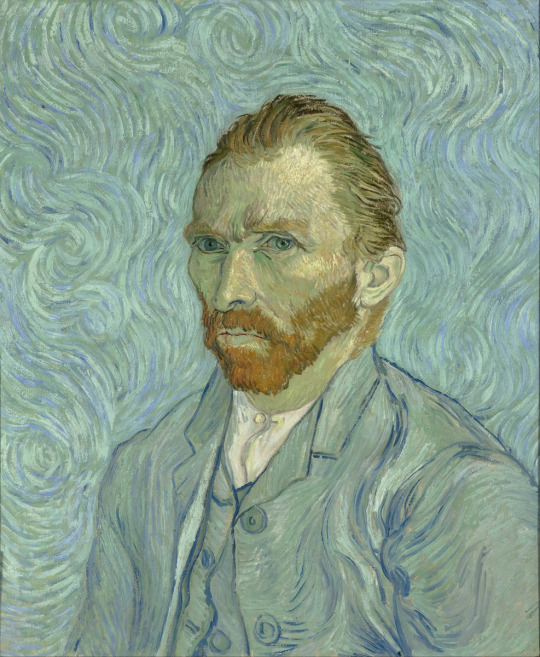
Self-Portrait | Vincent Van Gogh | 1889 | Musée d'Orsay
“Van Gogh took this penetrating self-portrait with him from Saint-Remy to Auvers. His facial expression is calm, but the background is turbulent. He thus visualised how he was trying to stand firm in the turmoil of his mental illness. Doctor Gachet was deeply moved by this painting. Van Gogh’s portrait of him was in a sense, also a kind of self-portrait. He saw the suffering of his own life reflected in Gashet’s sad expression of out times”
#Self-Portrait#vincent van gogh#Musée d'Orsay#Paris#france#The Netherlands#Amsterdam#Saint-remy#saint ramy#auvers#Neoimpressionism#blue#genius#dutch
9 notes
·
View notes
Photo
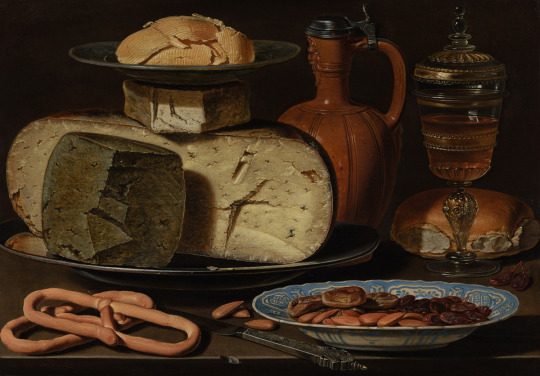
Still Life with Cheeses, Almonds and Pretzels | Clara Peeters | 1615 | Mauritshuis, The Hague
“In this still-life, a table is laid with cheeses, pretzels and figs, alongside costly objects like a gilded Venetian glass and a Chinese dish. The Antwerp painter Clara Peeters was one of the first food still-life painters, and her ‘banketjes’ or banquet pieces had a great influence on the painters of the Northern Netherlands. Besides putting her signature on the silver bridal knife, Peeters also painted herself. In the pewter lid of the earthenware jug, you can see the reflection of a woman’s face with a white cap. This is Clara’s self-portrait.”
#Still Life with Cheeses Almonds and Pretzels#clara peeters#Mauritshuis#den haag#The Hague#The Netherlands#dutch#antwerp#belgium#Flemish#still life
38 notes
·
View notes
Photo
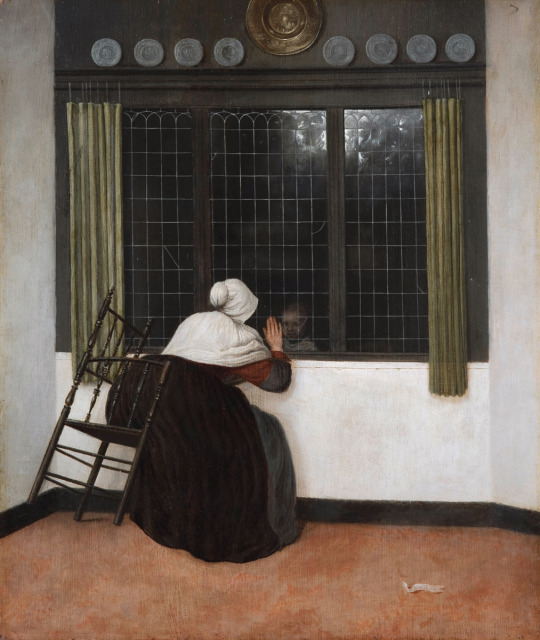
A seated woman looking at a child through a window | Jacobus Vrel | 1656 | Fondation Custodia, Paris
“The subject of this work is unique in 17th-century Dutch painting. No one else has ever depicted a woman tipping her chair forward yo look through a window. The woman makes contact with a girl on the other side of the glass. This is not an exterior window, but a window into another room - not unusual in 17th-century houses. Vrel struggled with the chair: he adjusted the length and exact position of the chair legs while he was painting it. He also had trouble with the perspective of the corners of the room. It is small details, such as the child behind the glass or the nail and its shadow on the white plastered wall, that make this a joy to look at. The way Vrel signed the work is also delightful - on a strip of paper lying seemingly unnoticed on the floor. It is a device he used often.
The well-known collector Frits Lugt (1884 - 1970), who had a penchant of the work of little-known artists, bought this painting in 1918. He then lent it for two years to the Mauritshuis, which doesn't have a work by Veel in its collection.”
#fondation custodia#paris#Dutch Golden Age#golden age#jacobus vrel#dutch#netherlands#Delft#Johannes Vermeer#vermeer#Mauritshuis#A seated woman looking at a child through a window#Pieter de Hooch
321 notes
·
View notes
Photo
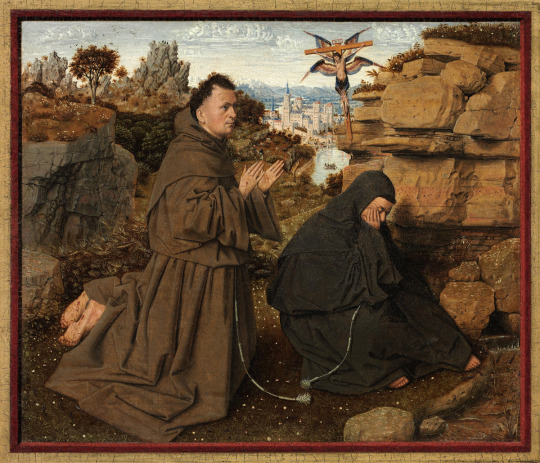
Saint Francis of Assisi Receiving the Stigmata | Jan van Eyck | 1432 | Philadelphia Museum of Art
“This brilliant display of Jan van Eyck’s microscopic technique highlights his ability to create pictures that seem at once very sharp yet very far away. The artist meticulously depicted the moment during a forty-day fast in the wilderness when Francis of Assisi received the wounds of the crucified Christ, who is seen here held aloft by a seraph, or angel. Although Van Eyck positioned the scene in the rocky landscape of legend, he included a bustling Netherlandish city in distance, as if to suggest that the miracle is visible outside boundaries of time or geography.The picture’s small size suggests that it was intended as a portable and personal object, one easily held in the hands and filled with details that reward close and repeated examination. The painting likely traveled in the artist’s lifetime or shortly thereafter, possibly on an early owner’s pilgrimage to Jerusalem.”
#jan van eyck#saint francis of assisi receiving the stigmata#saint francis of assisi#renessaince#northern renaissance#Flemish#The Netherlands#holland#brugge#bruges#philadelphia
18 notes
·
View notes
Photo

Virgin and Child with Canon van der Paele | Jan van Eyck | 1436 | Groeningemuseum, Bruges
“The Virgin and Child is set in a rounded church with side ambulatories, with Mary occupying the area where the altarpiece would usually be positioned. The panel has an overall sculptural look; the throne, windows, arches and hanging canvases borrow from the conventions of Romanesque architecture. After the "Adoration of the Mystic Lamb" panel of the Ghent Altarpiece, it is van Eyck's second largest extant painting, and the only one in a horizontal framing. The Virgin and Child is characterised by its innovative use of illusionism and complex spatial composition. It is in its original oak frame, which contains several Latin inscriptions, including van Eyck's signature, the date of completion, the donor's name, and texts related to St. George and St. Donatian. The upper border contains phrases from the Book of Wisdom, comparing Mary to an "unspotted mirror". The figures, the minutely detailed clothes, and the architecture of the room and windows are depicted with a high degree of realism. Van Eyck's mastery at handling oil can be seen in the differing breadths of brush strokes. The precision of the detail achieved is especially noticeable in the rendering of threads of St. Donatian's blue and golden embroidered cope and mitre, in the weave of the oriental carpet, and in the stubble and veins on van der Paele's aging face.”
#Virgin and Child with Canon van der Paele#jan van eyck#groeningemuseum#bruges#brugge#renessaince#northern renaissance#The Netherlands#nederland#belgie#belgium#virgin#st. donatian#st. george
1 note
·
View note
Photo
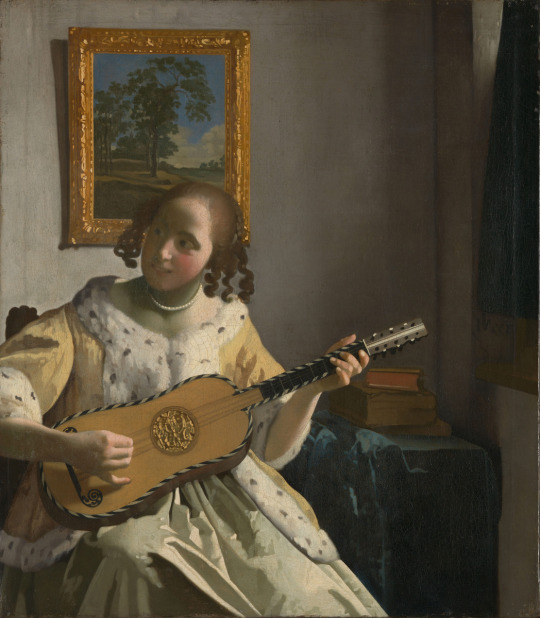
The Guitar Player | Johannes Vermeer | 1672 | Kenwood House
“Together with the Lacemaker (Louvre, Paris), this painting constitutes one of the best achievements by Vermeer, and certainly a towering success in his late maturity. By now, the artist had attained the mastery of light and colours, together with complete freedom of expressing himself technically by means of looser brushstrokes that are no longer bound to specifics of texture or materials. The model is not drawn inward but looks to the outside world in full communication and radiance of her pleasure simply to make music. Never was Vermeer more able to liberate himself from all constraints and convey his artistic viewpoint in a more masterly manner. The landscape on the back wall seems to be painted in the style of Hackaert.”
#Johannes Vermeer#vermeer#Dutch Golden Age#baroque#kenwood house#english heritage#dutch#The Netherlands#Delft#the guitar player#de gitaarspeelster
7 notes
·
View notes